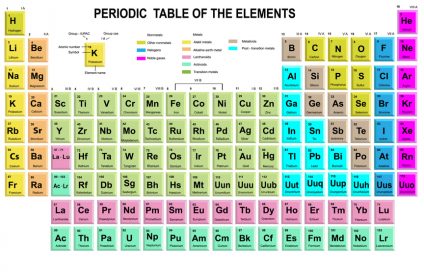
Anti-vaxxers don’t know much about vaccines. Even worse, they don’t know much about chemistry and biochemistry, which means that they can’t understand why they are so wrong about even their simplest claims.
Consider their erroneous claims about the “neurotoxins” in vaccines including mercury and aluminum. Those claims are based on confusion about the most basic distinction in chemistry, the difference between an element and a compound.
[pullquote align=”right” cite=”” link=”” color=”” class=”” size=””]The characteristics water are very different from the characteristics of its two elements hydrogen and oxygen.[/pullquote]
What’s the difference between an element and a compound and why does it matter?
Elements are the building block of all matter in the universe. Each element consists of only one kind of atom.
What’s an atom?
You’ve probably seen a picture like this before.

It shows the structure of an atom. Protons and neutrons are located in the center and electrons orbit around the center. The number of protons in the center determines the identity of the element. All atoms with one proton are elemental hydrogen; all atoms with two protons are elemental helium; and so on.
All the known elements are listed in the periodic table of the elements, in order of the number of protons.

Why are the elements arranged in this way? It’s because elements in each vertical row share important characteristics in how they combine with other elements to form compounds.
What’s a compound?
A compound consists of atoms of two or more different elements joined together and has properties that are different from its component elements.
A compound is different from a mixture. I can make a mixture of two gasses, hydrogen and oxygen. The hydrogen and oxygen are not connected with each other and the hydrogen atoms and oxygen atoms will retain their distinct characteristics.
If I introduce a spark to the mixture a chemical reaction will occur: hydrogen atoms will bind with oxygen atoms to form a compound, H2O or water. Although water is made up of hydrogen and oxygen, it no longer has the properties of either hydrogen or oxygen. For example, you couldn’t possibly breathe water and survive, even though water contains large amounts of oxygen. The characteristics of the compound water are different from the characteristics of its two elements hydrogen and oxygen.
But that’s not all. Other compounds can be made from the same elements hydrogen and oxygen. Hydrogen peroxide has the chemical formula H2O2. Though hydrogen and oxygen are gasses, peroxide, like water, is a liquid, but it’s a very different liquid from water. You don’t need to be a chemist to tell the difference between washing out a cut with water and washing it out with hydrogen peroxide.

So the elements hydrogen and oxygen have distinct properties but compounds made from them have very different properties from their constituent elements and from each other depending on the ratio of the elements within them.
An even more dramatic example of this principle is table salt. Salt is the compound NaCl, sodium chloride. Sodium is explosive and chlorine gas is poisonous. Either can cause serious harm or death, yet it’s difficult to imagine a less dangerous substance than table salt, a compound of dangerous elemental sodium and dangerous elemental chlorine.
What does this have to do with vaccine safety?
The principle that we’ve just explored, that compounds have very different characteristics than their constituent elements, has critical implications for anti-vax claims. Anti-vaxxers point out correctly that elemental mercury and elemental aluminum are neurotoxins. But that tells us NOTHING about whether mercury compounds and aluminum compounds are harmful or safe. Indeed, the mercury compounds that used to be present in vaccines (and are still present in some flu vaccines) and aluminum compounds in vaccines are quite safe even though mercury and aluminum are not.
This is obvious to anyone who understands basic chemistry, but can be quite mystifying to those who don’t.
Insisting that vaccines contain neurotoxins because they contain mercury or aluminum compounds is like insisting that you can breathe water because it is an oxygen compound. It’s not merely a reasoning error; it’s a sign of ignorance.

